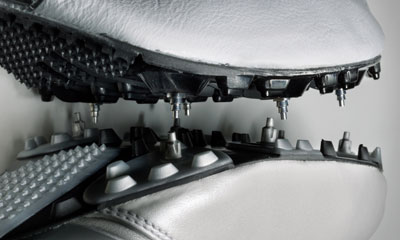| Posted: August 16, 2008 |
Adidas' revolutionary nanotechnology shoe for Beijing Olympics |
|
(Nanowerk News) adidas worked with Olympic 400m runner Jeremy Wariner for more than two years to create the revolutionary adidas Lone Star spike, which is named after Wariner's home state of Texas. The Lone Star is the world's first asymmetrical 400m spike, featuring the first ever full-length carbon nanotubes reinforced plate and the exclusive adidas progressive-compression spike.
|
|
"We spent more than two years working with Jeremy Wariner, the best curve runner in the world to design the adidas Lone Star," said Mic Lussier, adidas Innovation Team Leader, adidas America. "We know long-sprint races are won and lost in the curves so we looked at what he already does best and from there created the finest curve running shoes in the world. The adidas Lone Star allows Jeremy to push even better in the turn and provides him with even more physical confidence, stability and efficiency."
|
 |
|
First Ever Carbon Nanotubes Full-Length Plate
|
|
Leveraging new innovations from the plastics industry, adidas applied nanotechnology materials only previously used in the automotive and aerospace industries to design a carbon nanotubes reinforced full-length plate (nanoplate). This thinner and stronger one piece, full-length plate provides Wariner more stability, comfort, better torsion, safety and increased flexibility while minimizing the energy loss.
|
|
Mechanical and chemical bonds with the carbon nanotubes increase the structural integrity and durability of the plate, allowing adidas to build one continual flexible piece as opposed to the previous three-piece design, which included metal screw-in spikes and multiple fold points adhered together by cement. The new full-length plate measures about 1/3 the thickness of Jeremy's previous spike and weighs 50 percent less, making it the lightest spike ever created by adidas.
|
|
With less material between his foot and the track, the new plate allows Jeremy's feet to be closer to the ground, therefore promoting more natural movement of the foot. The material's defining physical properties result in increased flexibility, torsion and less energy loss as Jeremy's foot comes off the track.
|
|
World's First Asymmetrical 400m Spikes
|
|
After studying Wariner's running pattern in the adidas labs through high-speed video and pressure mapping, adidas worked with him to create something entirely new in long-sprint running. The adidas team of advanced engineers, designers and biomechanists were able to see how differently Wariner uses each foot as he runs.
|
|
As a result of these differences, they developed the first-ever asymmetrical spikes to cater to the specific needs and the role of each foot, and to build on the fact that long-sprint races are won in the curves. Similar to a race car having different suspension on the left and right sides to race in the curves, adidas created different shoes to build on the fact that Wariner uses his left foot for stabilization and his right foot for propulsion.
|
|
New Progressive-Compression Spike
|
|
Acting like a piston on the track, the progressive-compression spike design innovation is exclusive to adidas. Traditional spikes cut into the track material causing athletes to exert unnecessary energy with each stride as they pull the spike back out of the track. The revolutionary spike on Jeremy's shoe allows him to compress the track, thus riding its surface like a piston instead of digging in and out of it with each stride and wasting valuable energy. The tapered grooves of the progressive-compression spike provide the best penetration/compression ratio, thus optimizing the spring-like elastic property of the track surface.
|

